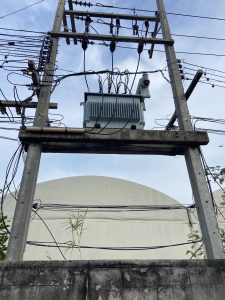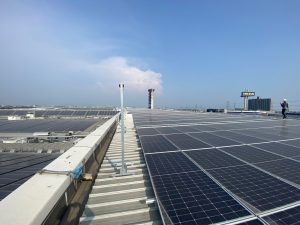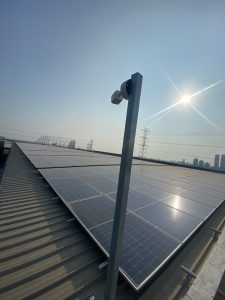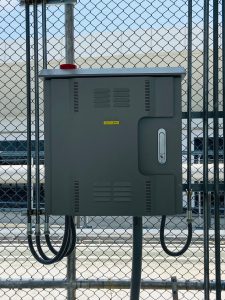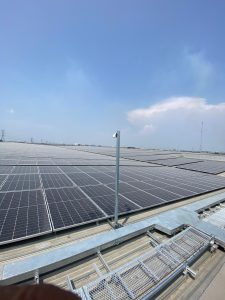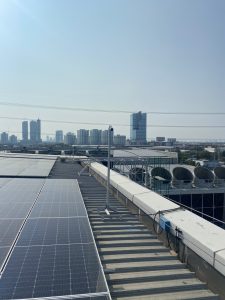งานบริการติดตั้ง / ออกแบบระบบ
Installation and Design of Solar Cell Rooftop Systems
Contracting for Installation and Design of Electrical Systems, Electrical Wiring, Transformer Installation, Solar Cell Systems, High Voltage 3-Phase and Low Voltage Design Inside and Outside Buildings
Contracting and Extending Electrical Systems for Homes, Office Buildings, and Factories
With Skilled Electricians Specializing in Electrical Work
We have certified electrical engineers for designs and installations of main electrical systems
How to Choose the Right Type of Electrical Wire for Each Job to Avoid Errors and Hazards When in Use
Types of Electrical Wire
Electrical wires can be broadly divided into two main categories: wires for low voltage and high voltage. This article will discuss the types of wires used in residential buildings, which fall under the low voltage category. In Thailand, low voltage wires must comply with the standards of TIS 11-2531. According to the standards, low voltage wires come in various sizes (cross-sectional area), ranging from small to large, capable of withstanding voltages from 300 volts to 750 volts. Wires according to TIS 11-2531 are classified based on size, voltage tolerance, and application as follows:
- IV Wire (สายไอวี): This type is a single-core wire designed for 300-volt applications, used for wiring into buildings for residential use with a single-phase system. It is prohibited for use with three-phase systems at 380 volts. When installed overhead, it must be secured with insulating materials, or run in dry wiring conduits, but it is prohibited to be laid in underground pipes or directly buried.
- VAF Wire (สายวีเอเอฟ): This wire is also rated for 300 volts and can be single or double-core, with ground wires. A single-core wire is round, while two or three-core wires are flat. The conductor is insulated and has an additional outer sheath. Double-core wires are commonly installed along walls with cable clips or run in conduits, but direct underground installation is prohibited. If this type of wire is installed underground, it must be placed in water-resistant conduits. This wire cannot be used in three-phase circuits at 380 volts (however, it can be used in three-phase systems that are separated for single-phase use at 220 volts).
- THW Wire (สายทีเอชดับเบิลยู): This is a single-core wire rated for 750 volts and widely used, especially in industrial settings, for normal three-phase electrical circuits. The cores of this wire type are made of copper and can be bundled into larger wires. It is typically used overhead with insulation supports, in conduits, or in underground conduits that are water-resistant. Direct burial is prohibited.
- NYY Wire (สายเอ็นวายวาย): Available in both single-core and multi-core types, this wire can also handle 750 volts and is widely used due to its durability against environmental conditions, featuring an additional outer sheath. For single-core NYY wires, there is one layer of insulation and one outer sheath to protect against physical damage. Multi-core NYY wires are twisted together into a round shape and have an additional outer sheath for protection. The two and four-core types meet various application needs, and the four-core version includes a neutral wire (NYY-N), suitable for four-wire three-phase circuits. There are also NYY wires with grounding (NYY-G), which include ground wires for connecting electrical devices that require grounding. All types of NYY wires can be buried underground due to their protective outer sheath.
- VCT Wire (สายวีซีที): This round wire is available in one, two, three, and four cores, rated for 750 volts, and features insulation and an outer sheath similar to NYY wires. A unique characteristic is that its conductor is made of fine copper strands twisted together, allowing flexibility and resistance to vibration. This wire is suitable for connections to machines that experience vibrations. It can be used similarly to NYY wires, with a grounding version available (VCT-G) that includes ground wires for devices requiring grounding. VCT wires can be directly buried.
Electrical wires come in various types, including copper and aluminum conductors, each divided into several categories based on the customer’s usage needs. For instance, copper conductors with PVC insulation and a rigid structure include THW, VAF, VAF-GRD, NYY, NYY-GRD 0.6/1KV-CV, while flexible copper conductors include VCT, VCT-GRD, VSF, AV, VFF, VKF. Aluminum conductors also have rigid types like THW-A, THWA-C, NAY, and SAC25-35KV. Each type is further divided into different sizes, which should be selected according to the application. Therefore, when considering the selection of suitable electrical wires, several factors must be taken into account, impacting efficiency, reliability, and safety in usage. Key considerations for selecting electrical wires include voltage rating, current rating, voltage drop, and multiple conductors.
Types of Electrical Wires
Low Voltage Power Cable: These cables are used for voltages not exceeding 750 V. They are insulated and made of copper or aluminum. Generally, small copper wires are single conductors, while larger wires are stranded conductors. The insulation materials used for low voltage cables are Polyvinyl Chloride (PVC) and Cross-Linked Polyethylene (XLPE), including THW, VAF, VAF-GRD, NYY, NYY-GRD, 0.6/1KV-CV, VCT, VCT-GRD, VSF, AV, VFF, and VKF.
High Voltage Power Cable: These are larger stranded conductors divided into two categories: bare wires and insulated wires.
- Bare Wires: – Bare Aluminum Stranded Wire (AAC)
– Aluminum Alloy Wire (AAAC)
– Aluminum Conductor Steel Reinforced Wire (ACSR) - Insulated Wires: – Partial Insulated Cable (PIC)
– Space Aerial Cable (SAC)
– Preassembly Aerial Cable
– Cross-linked Polyethylene (XLPE)
Electrical wires produced according to other standards refer to wires not manufactured to TIS 11-2531 or TIS 293-2541 standards. These wires are copper or aluminum conductors with insulation types other than PVC. Commonly used insulation includes Cross-Linked Polyethylene (XLPE).






